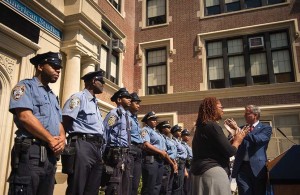Lessons on School Discipline, from South Carolina to NYC
Resource type: News
City & State | [ View Original Source (opens in new window) ]
By Miaija Jawara and Kesi Foster

When the world saw the recent video of a white police officer brutalizing a young black woman in her high school classroom in South Carolina by putting her into a chokehold, flipping her over in her desk and throwing her across the classroom, we were horrified. Sadly, we weren’t surprised. Unfortunately, videos and images of police brutality against black children and women have become so common, the hashtags so familiar, that #assaultatSpringValleyHigh was all too similar to #mckinneypoolparty, an attack on a 14-year-old black girl by a white police officer at a kids’ pool party in Texas.
In New York City, more than 90,000 high school students go through metal detectors every morning, and almost all of them are black and Latino. Black and Latino students make up 69 percent of all students, but account for 89 percent of all students suspended and 94 percent of all students that are arrested. While the numbers for suspensions and arrests have declined, we will not know the full extent of arrests, criminal summons and suspensions in our schools until the NYPD and Department of Education release the data that must now be collected as part of recent amendments to the Student Safety Act. As of now, the arrest and summons data only reflect the NYPD’s School Safety Division and do not include the number of arrests and summons carried out by local precinct officers.
The drop in suspensions shows that the de Blasio administration’s policy changes are beginning to have a positive impact, and we applaud the $2.4 million that the City Council has put forth to expand restorative justice efforts in schools. But New York has alarmingly high suspension rates for black students, four times as high as their white peers. The fact that “disorderly conduct” accounts for the overwhelming majority of criminal summons in schools should be more than enough to start the reform drumbeat. Mayor Bill de Blasio should address the racial inequities in school discipline and eliminate out-of-school suspensions for a B21 infraction, “defying authority,” and other minor infractions. The mayor should also immediately eliminate arrests and criminal summonses for “disorderly conduct,” possession of marijuana and other behavior that would best be handled within school communities.
As a young black woman who goes to high school in New York City, one of us (Miaija) is constantly surrounded and forced to interact with police in and around school. There is no metric for the emotional toll and trauma that youth of color face when schools feel more like prisons. When you walk up to school and there is a line of students waiting outside, you know it’s because there is a roving metal detector on the other side of the door. Right away, you get a bad feeling in your stomach. Are they going to tell me to take the pins out of my hair? Will they pull something embarrassing out of my bag? Will I be wanded down?
Both young women assaulted in South Carolina (another female student was arrested in the classroom for allegedly yelling and cursing at the officer) were charged with, and are still facing, charges for “disturbing the school,” an ambiguous term used to funnel young people into the criminal justice system. Similarly, New York City continues to use “defying authority” as an offense worthy of suspension and “disorderly conduct” as an offense worthy of arrest. Both push young black and Latino youth out of their classroom and into the courtroom. “Disorderly conduct” could be a schoolyard fight, the kind that resulted in one of us (Miaija) receiving a criminal summons, or it could be a young person refusing to put away a cellphone.
Low-income New Yorkers of color have been plagued for years by an unjust system of “broken windows” policing that penalizes them for being poor and black and Latino, and that has continued through the front doors of our schools. The Department of Education now spends close to $400 million annually on “school safety.” If the School Safety Division were a municipal police force, it would be the nation’s fifth largest. But there is no research that policing schools is effective for creating a safe and supportive educational environment. What we do know is that having police in schools increases the number of young people referred to the juvenile justice system for minor infractions.
Our current school discipline policies and funding priorities undermine efforts to create nurturing learning environments for all schoolchildren. The mayor’s Leadership Team on School Climate and Discipline has put forth important recommendations and the implementation of those recommendations is a significant step forward. But if the mayor is determined to permanently disrupt the school-to-prison pipeline, he needs to take bold steps to redress the over-policing of young people of color in schools.
We should not pretend that what happened in the halls of Spring Valley High School could not or has not happened in the halls of a school in our city. Sadly, it’s part of the same criminalization of young black and Latino students that occurs in our schools every day. We must stop it now.
Miaija Jawara is a high school student in Harlem. Kesi Foster is the coordinator of the Urban Youth Collaborative. The Urban Youth Collaborative (via the Just and Fair Schools Fund from Public Interest Projects) is an Atlantic grantee.